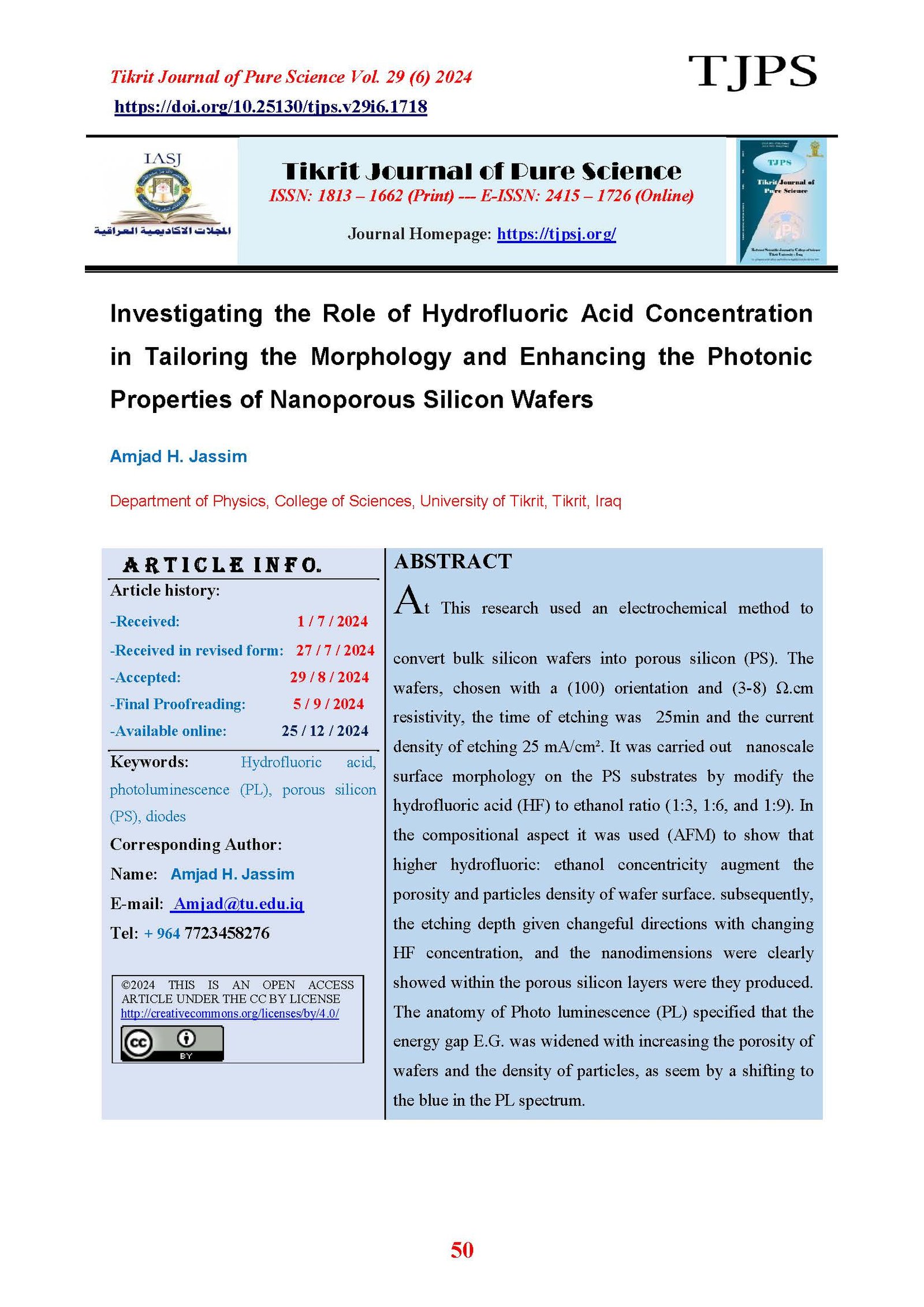Investigating the Role of Hydrofluoric Acid Concentration in Tailoring the Morphology and Enhancing the Photonic Properties of Nanoporous Silicon Wafers
Main Article Content
Abstract
At This research used an electrochemical method to convert bulk silicon wafers into porous silicon (PS). The wafers, chosen with a (100) orientation and (8-3) Ω.cm resistivity, the time of etching was 25 min and the current density of etching 25 mA/cm². It was carried out nanoscale surface morphology on the PS substrates by modify the hydrofluoric acid (HF) to ethanol ratio (1:3, 1:6, and 1:9). In the compositional aspect it was used (AFM) to show that higher hydrofluoric: ethanol concentricity augment the porosity and particles density of wafer surface. subsequently, the etching depth given changeful directions with changing HF concentration, and the nanodimensions were clearly showed within the porous silicon layers were they produced. The anatomy of Photo luminescence (PL) specified that the energy gap E.G. was widened with increasing the porosity of wafers and the density of particles, as seem by a shifting to the blue in the PL spectrum
Article Details

This work is licensed under a Creative Commons Attribution 4.0 International License.
Tikrit Journal of Pure Science is licensed under the Creative Commons Attribution 4.0 International License, which allows users to copy, create extracts, abstracts, and new works from the article, alter and revise the article, and make commercial use of the article (including reuse and/or resale of the article by commercial entities), provided the user gives appropriate credit (with a link to the formal publication through the relevant DOI), provides a link to the license, indicates if changes were made, and the licensor is not represented as endorsing the use made of the work. The authors hold the copyright for their published work on the Tikrit J. Pure Sci. website, while Tikrit J. Pure Sci. is responsible for appreciate citation of their work, which is released under CC-BY-4.0, enabling the unrestricted use, distribution, and reproduction of an article in any medium, provided that the original work is properly cited.
References
[1] Andersen, O.; Veje, E. Experimental study of the energy-band structure of porous silicon. Physical review 1996, 53, 15643.
https://doi.org/10.1103/PhysRevB.53.15643
]5[Abramof, P.; Ferreira, G.; et al. "X-ray investigation of nanostructured stain-etched porous silicon." Journal of applied physics 2006, 99, 2 . https://doi.org/10.1063/1.2162273
]3[ Ismail, K.; Ahmad, Y.; Hassin, A. Preparation of porous silicon Wafers using sun light photo chemical etching (SLPCE). Tikrit Journal of Pure Science 2023, 23, 7, 78–84. https://doi.org/10.25130/tjps.v23i7.700
]4[ Tsybeskov, L.; Fauchet, P. Silicon-based visible light-emitting devices inte- grated into microelectronic circuits. Nature, 1996,
384, 6607, 338–341. http://dx.doi.org/10.1038/384338a0
]5[ Striemer, C.; Gaborski, T.; Fauchet, P. Charge- and size-based separation of macro- molecules using ultrathin silicon membranes. Nature. 2007, 445, 7129, 749–753. http://dx.doi.org/10.1038/nature05532
]6[ Lin, K.; Motesharei, K.; Dancil, M. A porous silicon-based optical interferometric biosensor. Science, 1997, 278, 5339, 840–843. 10.1126/science.278.5339.840
]7[ Kumar, P.; Huber, L. Nucleation and growth of copper on mesoporous silicon by immersion plating. Journal of Physics D: Applied Physics, 2007, 40, 9, 2864–2869. http://dx.doi.org/10.1088/0022-3727/40/9/030
]8[ Foll, H.; Carstensen, J.; Frey, S. Porous and nanoporous ¨ semiconductors and emerging applications. Journal of Nano- materials. 2006, 2006, 1, 1-10 https://doi.org/10.1155/JNM/2006/91635 [9] Amjad, H. Effect of photo chemical etching and electro chemical etching on the topography of porous silicon wafers surfaces. Tikrit Journal of Pure Science, 2019, 24, 4, 52–56. https://doi.org/10.25130/tjps.v24i4.399 [10] Amjad, H.; Hanaa, E.; Shihab A. Najat A. Effect of wafer resistivity and light intensity on the topography of porous silicon surfaces produced by photo chemical method. Tikrit Journal of Pure Science, 2023, 23, 6, 131–139. https://doi.org/10.25130/tjps.v23i6.682 [11] Zhang, X. Morphology and formation mechanisms of porous silicon,” Journal of the Electrochemical Society. 2004, 1511, 69–80. https://doi.org/10.1149/1.1632477 [12] Nurhaziqah, K.; Kok, S. Effect of HNO 3 Concentration on Etch Rate and Structure of Si Wafer Etched in the Mixture of HF and HNO 3 Solutions. ASM Science Journal 2018, 11, 1, 68-74. https://ssrn.com/abstract=4345962
[13] Adwan, N. Photoluminescence lifetime in porous silicon. Tikrit Journal of Pure Science 2023, 21, 1, 76–81. https://doi.org/10.25130/tjps.v21i1.953 [14] Canham, T.; Calcott, P. The structural and luminescence properties of porous silicon. Journal of Applied Physics. 1997, 82, 3, 909–965. https://doi.org/10.1063/1.366536 [15] Bisi, O.; Ossicini, S.; Pavesi, L. Porous silicon: a quantum sponge structure for silicon-based optoelectronics. Surface Science Reports, 2000, 38, 3, 1–126 https://doi.org/10.1016/S0167-5729(99)00012-6
